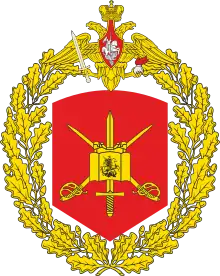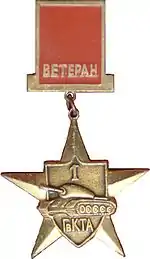1st Guards Tank Army (Russia)
The 1st Guards Tank Army is a tank army of the Russian Ground Forces.
| 1st Tank Army (1942 – April 1944) 1st Guards Tank Army (1944–1999, 2014–) | |
|---|---|
 Great emblem of the 1st Guards Tank Army | |
| Active | 1942–1998, reinstated 2014 |
| Country | |
| Type | Armoured |
| Role | Breakthrough and Exploitation in Deep Operations |
| Size | 500–800 tanks |
| Engagements | World War II |
| Decorations | |
| Commanders | |
| Current commander | Lieutenant General Sergei Kisel |
| Notable commanders | Kirill Moskalenko Mikhail Katukov |

The army traces its heritage back to the 1st Tank Army, formed twice in July 1942 and in January 1943 and converted into the 1st Guards Tank Army in January 1944. The army fought as part of the Red Army on the Eastern Front during World War II. The army was commanded throughout most of the war by Mikhail Katukov. It fought in the early defense during the Battle of Stalingrad, and Operation Uranus, also participated at the Battle of Kursk, Proskurov-Chernovtsy Operation, Lvov-Sandomierz Operation, Vistula-Oder Offensive and the Battle of Berlin. After the war, the army was stationed in East Germany as part of the Group of Soviet Forces in Germany.
After the end of the Cold War and the resultant withdrawal of Soviet units in Germany, the army was relocated to Smolensk, disbanded in 1999. The army was reformed in 2014 as part of a Russian military expansion.
First Formation
The 1st Tank Army was first formed within the Stalingrad Front from 38th Army in July 1942, under the command of Major General Kirill Moskalenko. The army was encircled and partially destroyed, and was disbanded as a result in August 1942, its headquarters becoming the Southeastern Front headquarters.
Second Formation
The 1st Tank Army was formed a second time on 30 January 1943 (order No.46021) from the headquarters of the 29th Army, under the command of famous armoured troops commander Lieutenant General of Tank Troops Mikhail Katukov, personally appointed by Stalin. The army was transferred to the North-Western Front. 3rd Mechanised Corps (later to become 8th Guards Mechanised Corps) and 6th Tank Corps (later to become 11th Guards Tank Corps) joined it on formation, and served with the army throughout the war.[1] It was quickly transferred to Voronezh Front for the defense of the Kursk salient's southern shoulder. It was awarded a Guards title and became the 1st Guards Tank Army in April 1944, and Katukov was promoted to Colonel General.
On 1 January 1945, the Army's principal combat formations were:[2]
- 8th Guards Mechanized Corps (Major General Ivan Dremov) (3 January 1944 – 9 May 1945)
- 19th Guards Mechanized Brigade
- 20th Guards Mechanized Brigade
- 21st Guards Mechanized Brigade
- 1st Guards Tank Brigade
- 48th Guards Separate Tank Regiment
- 353rd Guards Self-Propelled Artillery Regiment
- 400th Guards Self-Propelled Artillery Regiment
- 265th Guards Mortar Regiment *
- 405th Guards Mortar Battalion *
- 358th Guards Anti-Aircraft Artillery Regiment
- 8th Guards Motorcycle Battalion
- 11th Guards Tank Corps (Colonel Hamazasp Babadzhanian) (25 August 1944 – 9 May 1945)
- 40th Guards Tank Brigade
- 44th Guards Tank Brigade
- 45th Guards Tank Brigade
- 27th Guards Motor Rifle Brigade
- 399th Guards Heavy Self-Propelled Artillery Regiment
- 362nd Guards Self-Propelled Artillery Regiment
- 1454th Self-Propelled Artillery Regiment
- 350th Light Artillery Regiment
- 270th Guards Mortar Regiment *
- 53rd Guards Mortar Battalion *
- 1018th Anti-Aircraft Artillery Regiment
- 9th Guards Motorcycle Battalion
- Army Troops
- 64th Guards Tank Brigade
- 11th Guards Separate Tank Regiment
- 19th Light Self-Propelled Artillery Brigade
- 197th Light Artillery Brigade
- 79th Guards Mortar Regiment *
- 17th Motorised Engineer Brigade
- 191st Guards Liaison Aviation Regiment
- 6th Motorcycle Regiment
- 12th Guards Motorcycle Regiment
* Guards Mortar Regiment (or Battalion) (Russian: гвардейский минометный полк (дивизион)) was the overt designation used for Katyusha rocket launcher units.
It participated in the Battle of Kursk, the Proskurov-Chernovtsy Operation, Lvov-Sandomierz Operation, the Vistula-Oder Offensive, and the Battle of Berlin.
The 1st Guards Tank Army was awarded the Order of the Red Banner postwar, and became part of the Soviet occupation force in Germany, known as Group of Soviet Forces in Germany, with its headquarters in Dresden. In 1968, it, along with the 11th Guards Tank and 20th Guards Motor Rifle Divisions, took part in the Soviet invasion of Czechoslovakia, but then immediately returned to their respective garrisons.[3] In the late 1980s the Army included the 20th Guards Motor Rifle Division, 9th Tank Division, and 11th Guards Tank Division. The headquarters was withdrawn to Smolensk, in the Moscow Military District in the early 1990s, and lost the 'Tank' from its title in 1995. In its last period within the Russian Army it comprised the 4th Guards 'Kantemir' Tank Division and the 144th Motor Rifle Division (which had been withdrawn from Tallinn in Estonia). It was disbanded in 1998.
1988 Structure
The army's composition in 1988 was (with main equipment), with honorific titles in italics:[4][5]
- Army Headquarters, Dresden
- 234th Separate Guard and Security Battalion, Dresden
- 3rd Separate Guards Carpathian Communications Regiment, Dresden
- 253rd Separate Radio Engineering Regiment, Merseburg
- 51st Separate Radio Engineering Battalion, Dresden
- 106th Separate Electronic Warfare Battalion, Dresden
- 595th Separate Intelligence Gathering Battalion, Chemnitz (K-611)
- 6th Separate Airborne Battalion, Dresden
- 308th Artillery Brigade, Zeithain (2c5 Hyacinth)
- 181st Guards Novozybkovskaya Red Banner Orders of Suvorov and Alexander Nevsky Missile Brigade, Kokhstadt
- 432nd Missile Brigade, Wurzen
- 53rd Anti-Aircraft Missile Brigade, Altenburg
- 443rd Separate Engineer and Combat Engineering Battalion, Dresden
- 68th Pontoon Bridge Regiment, Dresden
- 41st Materiel Support Brigade, Dresden
- 225th Separate Attack Helicopter Regiment, Allstedt (Mil Mi-24)
- 485th Separate Attack Helicopter Regiment, Brandis (Mil Mi-24)
- 6th Separate Transport Helicopter Squadron, Klotzsche (Mil Mi-8)
- 9th Bobruisk-Berlin Order of the Red Banner Order of Suvorov Tank Division, Riesa
- 11th Guards Berlin-Carpathian Tank Division, Dresden
- 20th Guards Taganrog Red Banner Order of the Suvorov Division Motor Rifle Division, Grimma
Reactivation
After a 15-year break, the Army was reconstituted in November 2014,[6] seemingly on 13 November 2014.
The army was formed as the main ground forces manoeuvre and reserve operational formation of the Western Military District in addition to the 6th Combined Arms Army (headquartered in Saint Petersburg) and the 20th Guards Combined Arms Army (headquartered in Voronezh). It is considered the elite of the Russian Ground Forces. The army carries on the traditions of the chronologically first army of the Soviet Union to reach 'Guards' status. Further it has the 2nd Motor Rifle and the 4th Tank guards divisions, which are considered the elite formations of their respective combat arms. The most decorated divisions of the Soviet Army, they were garrisoned the closest to Moscow. Due to their proximity to the capitol their personnel was put to extra scrutiny, they were considered a very prestigious posting, received the latest hardware and thus known as the 'household' divisions of the Soviet Army. Their loyalty to the government was demonstrated by their involvement in the 1991 Soviet coup d'état attempt. The divisions retained their elite status within the Russian Army.
Today the Army is composed of:[7]
- Army Headquarters (Odintsovo, Moscow Oblast)
- 60th Command Brigade (Selyatino village near Odintsovo, Moscow Oblast)
- 2nd Guards Motor Rifle 'Tamanskaya' Division (Kalininets, Moscow Oblast)
- 4th Guards Tank 'Kantemirovskaya' Division (Naro-Fominsk, Moscow Oblast)
- 6th Separate Tank 'Częstochowa' Brigade (Mulino, Nizhny Novgorod Oblast)
- 27th Separate Guards Motor Rifle 'Sevastopol' Brigade (Mosrentgen, Moscow City)
- 112th Guards Missile 'Novorossiysk' Brigade (Shuya, Ivanovo Oblast) (9K720 Iskander)
- 288th Artillery 'Warsaw' Brigade (Mulino, Nizhny Novgorod Oblast)
- 49th Missile Air Defence Brigade (Krasnyi Bor, Smolensk Oblast) (Buk-M2)
- 96th Separate ISTAR Brigade (Sormovo, Nizhny Novgorod City)
- unknown Combat Engineer Regiment (in formation until the end of 2018)[8][9] (unknown location in Moscow Oblast)
- 20th Separate NBC Defence Regiment (Tsentralny, Nizhny Novgorod Oblast)
- 69th Separate Logistics Brigade (Dzerzhinsk, Nizhny Novgorod Oblast)
Commanders of the Army
- Katukov, Mikhail Yefimovich – Guard[10] ColGen, 1943–1947
- Belov, Yeftikhin Emelyanovich – Guard LtGen, 1947–1951
- Govorunenkov, Pyotr Dmitrievich – Guard GenLt, 1951–1953
- Yakubovsky, Ivan Ignatyevitch – Guard GenLt, 1953–1957
- Tolubko, Vladimir Fyodorovich – Guard MajGen, 1957–1958
- Ukhov, Vladimir Dmitrievich – Guard MajGen, 1958–1961
- Ivanovski, Yevgeny Filippovich – Guard MajGen, 1961–1964
- Kotsasnov, Konstantin Grigoryevich – Guard GenLt, 1964–1968
- Gerasimov, Ivan Aleksandrovich – Guard GenLt, 1968–1971
- Lushev, Pyotr Georgievich – Guard GenLt, 1971–1973
- Snetkov, Boris Vasilievich – Guard LtGen, 1973–1975
- Popov, Nikolai Ivanovich – Guard LtGen, 1975–1979
- Sovotskin, Roman Mikhailovich – Guard LtGen, 1979–1981
- Osipov, Vladimir Vasilyevich – Guard LtGen, 1981–1983
- Shein, Boris Pertovich – Guard LtGen, 1983–1986
- Tchernitsov, Anatoli Kupyanovich – Guard LtGen, 1986–1990
- Kolchkin, Gennadi Andreevich – Guard LtGen, 1990–1992
- Shevtsov, Leonti Pavlovich – Guard LtGen, 1992–1993
- Sosyedov, Vasili Petrovich – Guard LtGen, 1993–1995
- Roshchin, Viktor Mikhailovich – Guard LtGen, 1995–1999
- Did not exist (1999–2014)
- Chayko, Aleksandr Yurevitch – Guard LtGen, 2014–2018
- Kisel, Sergei Aleksandrovich - Guard LtGen, 2018-present
References
- Bonn, 2005, p.351, 354
- "1-я гвардейская Краснознаменная танковая армия". Archived from the original on 2009-10-25. Retrieved 2018-10-02.
- Craig Crofoot, manuscript available at Microarmormayhem.com, 2007
- "1st Guards Tank Army". www.ww2.dk. Retrieved 2020-03-30.
- "Western Military District History". 2011-09-28. Archived from the original on 2011-09-28. Retrieved 2020-03-30.
- "ВЗГЛЯД / Россия закрывает "черную дыру" на границе с Украиной". vz.ru.
- Defence, Russia. "Russian Army: Military districts, units (Locations, equipment and re-armaments)". Russia Defence Forum. Retrieved 20 May 2017.
- "В состав танковой армии Западного военного округа войдет новый инженерно-саперный полк : Министерство обороны Российской Федерации". function.mil.ru. Retrieved 2018-10-02.
- сборник, БАСТИОН: военно-технический. "ВООРУЖЕНИЯ, ВОЕННАЯ ТЕХНИКА, ВОЕННО-ТЕХНИЧЕСКИЙ СБОРНИК, СОВРЕМЕННОЕ СОСТОЯНИЕ, ИСТОРИЯ РАЗВИТИЯ ОПК, БАСТИОН ВТС, НЕВСКИЙ БАСТИОН, ЖУРНАЛ, СБОРНИК, ВПК, АРМИИ, ВЫСТАВКИ, САЛОНЫ, ВОЕННО-ТЕХНИЧЕСКИЕ, НОВОСТИ, ПОСЛЕДНИЕ НОВОСТИ, ВОЕННЫЕ НОВОСТИ, СОБЫТИЯ ФАКТЫ ВПК, НОВОСТИ ОПК, ОБОРОННАЯ ПРОМЫШЛЕННОСТЬ, МИНИСТРЕСТВО ОБОРОНЫ, СИЛОВЫХ СТРУКТУР, КРАСНАЯ АРМИЯ, СОВЕТСКАЯ АРМИЯ, РУССКАЯ АРМИЯ, ЗАРУБЕЖНЫЕ ВОЕННЫЕ НОВОСТИ, ВиВТ, ПВН, информация по военной технике, сайт по Военной технике". bastion-karpenko.ru. Retrieved 2018-10-02.
- Military personnel of the Soviet Armed Forces, assigned to service in a guards units or formations, added to the particular rank designation the wording Guard …, e.g. Guard Lieutenant General. This tradition is continued in the Russian Federation.
- Bonn, K.E. 'Slaughterhouse – The Handbook of the Eastern Front', Aberjona Press, 2005
- Duncan, Andrew 'Russian Forces in Decline – Part 3', Jane's Intelligence Review, November 1996.
- V.I. Feskov, Golikov V.I., K.A. Kalashnikov, and S.A. Slugin, The Armed Forces of the USSR after World War II, from the Red Army to the Soviet (Part 1: Land Forces). (В.И. Слугин С.А. Вооруженные силы СССР после Второй Мировой войны: от Красной Армии к Советской (часть 1: Сухопутные войска)) Tomsk, 2013.
- Glantz, David M. 'Companion to Colossus Reborn' University Press of Kansas, 2005.
